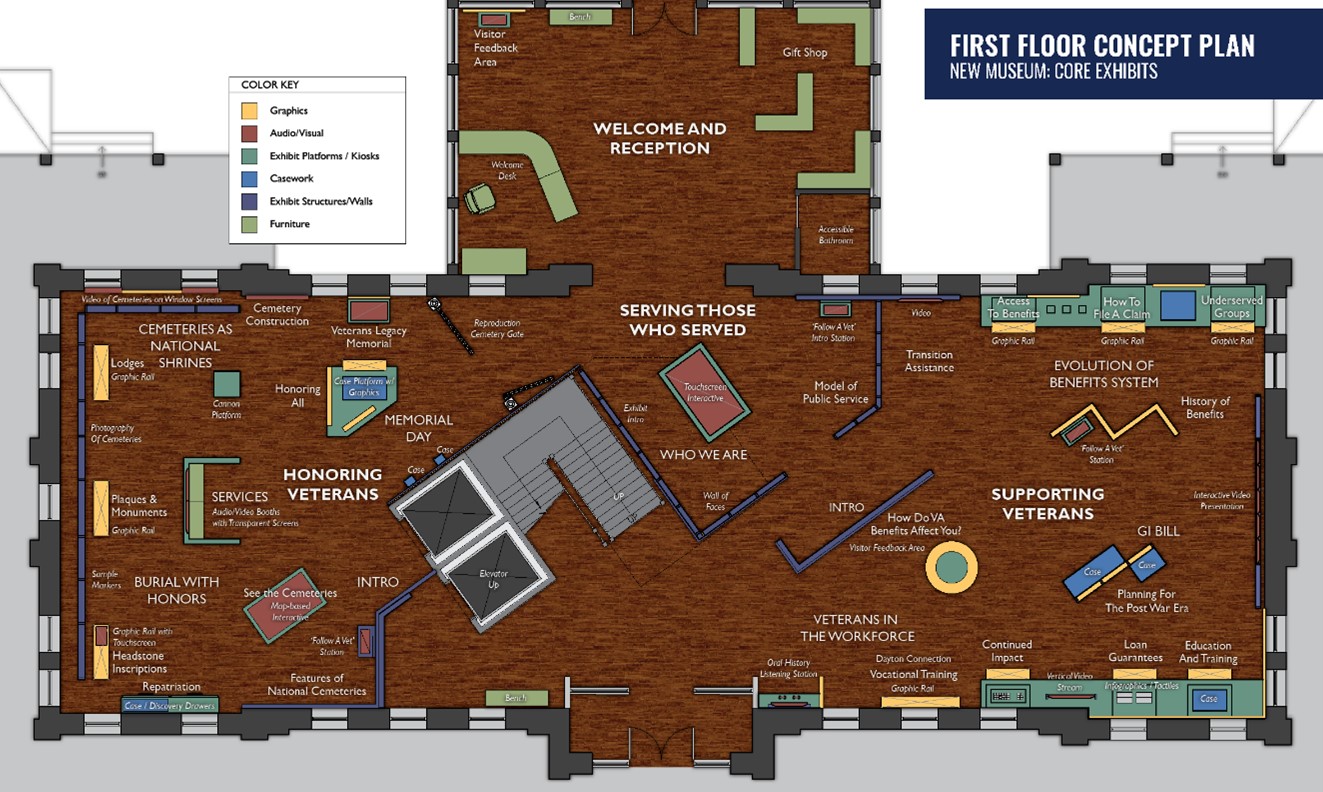
In December of 2022, the National VA History Center’s (NVAHC) Core Project Team completed the Interpretive Master Plan (IMP). The document was the culmination of an 18-month process working with a variety of internal and external stakeholders for the stories we will tell and how we will engage with you to tell them. Leading this process was a privilege, and it was both challenging and rewarding. I had the difficult task of trying to choose the most important themes from the thousands of possibilities across an agency as large as the VA. Healy Kohler Designs used our initial ideas and developed them into a comprehensive document.
It was an honor to work with passionate and talented individuals collaborating to develop this IMP. This IMP serves as the basis for the development of the museum and the exhibits and programs that it shares with visitors. It is 58 pages, so you may just want to look at the floor plans and renderings.

Now that the IMP is finished, we are starting to develop some of the visitor engagement plans. We are currently working on additional interpretive panels for the Dayton campus. With VA IT and contracting, we are developing an Augmented Reality tour application to engage visitors using their personal mobile devices. The application will use Augmented Reality to superimpose historic images over the current landscape, showing what the campus used to look like. It will also use holograms of key figures in the history of the home to tell interesting stories. The app will feature wayfinding and interactive maps. We plan to expand this application to other VA facilities once we implement the lessons learned.
We are also exploring the development of a Virtual Museum. This online version will allow access to the museum for everyone with an internet connection. It should be available prior to the physical museum, and it allows us to tell stories that may not fit within the museum. This Virtual Museum offers a great deal of flexibility in storytelling. These projects will require the digitization of our collections for use in the application and virtual museum.
Plans are also being developed for the Putnam Library (Building 120) to serve as the first public space for the NVAHC. Currently, those plans include a research room and archival exhibits. These projects are a few of the things we are working on. The next Curator Corner will share our move to building 126 and its impact on the NVAHC.
By Kurt Senn
Curator, National VA History Center
Share this story
Related Stories
Curator Corner
It isn’t often that researchers who work with historic objects get to know the people who used those objects every day. Sometimes we get lucky and can link artifacts to certain facilities or buildings on a historic VA campus, but usually we must look for more hidden lines of evidence to figure out how an object fits into the history of those who care for our Nation’s Veterans. As nice as it would be, it isn’t as if many artifacts turn up labeled with their owners’ names! So, imagine my surprise when my teammates and I began sweeping Putnam Library for any historic objects left behind before the building is closed for renovation, and found just that.
As far as artifacts go, its story seemed simple: book presses like these would have been used to help maintain and repair the thousands of books read in Putnam Library ever since it first opened in 1879. The day that I first got up close and personal with the press, I noticed a woman’s name scraped into the black paint of the platen (the technical name for the big metal plate used to hold books together). It said “Helen Carson” in big, legible letters. As we carefully transported the heavy press down the many stairs inside Putnam Library, I looked at the name and thought “Hm…wonder who that is?”.
Curator Corner
Mary Lowell Putnam is tied to VA history by her generous donation of a large volume of books to the Central Branch of the National Home for Disabled Volunteer Soldiers. These books, meant to honor her son who died in the Civil War, helped foster reading advancement for the Veterans who lived there after the war and into the 20th Century. However, her life was more than just a moment in time donating books. It included a life-long study of languages and a very sharp opinion that she shared in writing throughout her life.
Curator Corner
Presidents George Washington and Abraham Lincoln are among the most easily recognizable figures in American history. Their faces are symbols of wisdom, strength, and leadership. Even today, polls consistently rank them as the greatest or most successful presidents. With that in mind, it is unsurprising that the appreciation of these legendary statesmen has deep historic roots. In honor of their birthdays, our team at the National VA History Center explored those roots through this pair of plaster busts.






